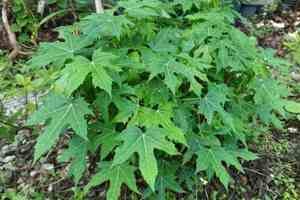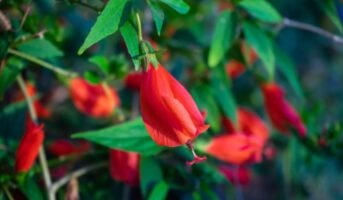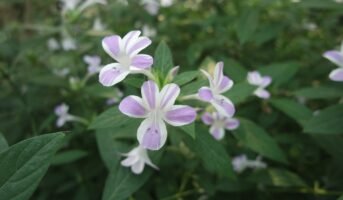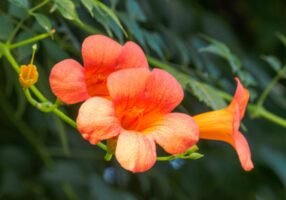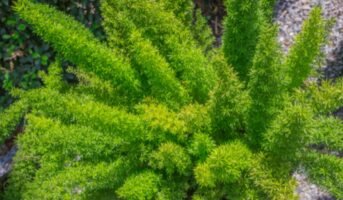Originally from the Yucatán Peninsula in Mexico, the large, fast-growing, and leafy perennial shrub known as Cnidoscolus Aconitifolius is known by a variety of common names- chaya, tree spinach, and cabbage star.
The name ‘Aconitifolius’ refers to the resemblance between the plant’s leaves and those of the Aconitum. It can thrive in rainy and arid regions and requires low maintenance.

Source: Pinterest
What is Cnidoscolus Aconitifolius?
Cnidoscolus Aconitifolius is a tropical shrub or small tree that grows to a height of up to six metres. With several culinary and medicinal uses, the plant is quite popular amongst gardeners. In addition to featuring pretty blooms and having a variety of applications, Cnidoscolus Aconitifolius is quite easy to grow and maintain. It is also planted as hedgerow in gardens and can be grown from softwood cuttings, semi-hardwood cuttings, and woody stem cuttings.
Cnidoscolus Aconitifolius: Key facts
| Scientific name | Cnidoscolus Aconitifolius |
| Common name | Tree spinach, cabbage star, chaya |
| Native to | Mexico |
| Family | Euphorbiaceae |
| Height | 5 m |
| Temperature | 20-35 ℃ |
| Soil | Loamy soil, clay |
| Water | Regular |
See also: What is Okra and what are its benefits
Cnidoscolus Aconitifolius: Features
Cnidoscolus Aconitifolius has a potential height of 5 metres but is typically kept at a height of 2 metres (6.6 feet) for ease of leaf harvesting. The panicle at the plant’s tip bears the white flowers that stand out so dramatically against the greenery.
The leaves of Cnidoscolus Aconitifolius are simple, alternating, and held on stalks that are 10-30 centimetres long and glandular at the tip. Flowers are produced in dimorphic cymes.
The flowers are unisexual, regular, and devoid of petals; sepals are in fives, up to one centimeter long, and resemble petals; male flowers have ten connected stamens in two whorls; female flowers have a superior, three-celled ovary with three fused styles.
The fruit of Cnidoscolus Aconitifolius is a bristly, ovoid-spherical capsule.
Cnidoscolus Aconitifolius: How to grow?
As seeds are hard to come by, most new Cnidoscolus Aconitifolius are grown from cuttings. Using cuttings of one- to two-year-old wood from specific varieties has proven effective. After about a week of drying in the shade, the 15–30 cm (6–12 in) cuttings are ready to be planted. The cuttings should be dried out completely before planting, as the softwood is vulnerable to fungal attacks in damp environments. That’s why you should never wet the cuttings before planting them.
Rooted stem cuttings 6-12 inches long are used for propagation and are plated at a depth of 3-4 inches below the surface. Aeroponic or soilless media can be used to root cuttings successfully. Cnidoscolus Aconitifolius grows well in a wide range of soil types but prefers moderately acidic to slightly alkaline soils (pH 5.5 to 8.0) and full to partial sunlight. Leaves on plants grown in partial shade are typically more delicate than those grown in full sun. Cnidoscolus Aconitifolius is less tolerant of waterlogged or poorly draining soils than many other plants.
Cnidoscolus Aconitifolius: Care tips
Here are some tips to keep in mind for maintaining Cnidoscolus Aconitifolius in your garden.
Cnidoscolus Aconitifolius: Climate requirements
Optimal conditions for growth are found in tropical regions, as it is sensitive to cold. A freeze may not kill a Cnidoscolus Aconitifolius completely if its roots are well protected. It is also possible to grow it in a container and bring it indoors for the winter.
Cnidoscolus Aconitifolius: Sunlight requirements
Traditionally, you need anywhere from direct sunlight to some shade. Cnidoscolus Aconitifolius can survive in shady conditions, but growth will be slower. While growing indoors, placing it near a sunny window is sufficient.
Cnidoscolus Aconitifolius: Water requirements
Needs low to moderate amounts of water. Cnidoscolus Aconitifolius are able to tolerate some levels of drought and flood.
Cnidoscolus Aconitifolius: Nutrients requirements
It is necessary for Cnidoscolus Aconitifolius to consume moderate to high levels of nutrients. Before you plant anything, amend the soil with compost. Once per growing season, apply a well-balanced organic fertiliser.
Cnidoscolus Aconitifolius: Mulching requirements
In climates with a moderately cold winter, it is important to use a mulch to prevent soil from drying out, and to shield the plant’s crown of Cnidoscolus Aconitifolius from light frosts.
Cnidoscolus Aconitifolius: How to harvest?
If you want harvesting to be easier, you should prune Cnidoscolus Aconitifolius so that they are at a height that is manageable. Trim the Cnidoscolus aconitifolius leaves off the stems when they are still young and tender. Trim only a third to a half of Cnidoscolus Aconitifolius at a time. To give plants the best possible start, harvesting should be delayed until the second year. Wearing gloves will protect your hands from the white latex sap and leaf hairs that may cause an allergic reaction.

Source: Pinterest
Where to keep Cnidoscolus Aconitifolius?
Cnidoscolus Aconitifolius thrives in full sun and prefers to grow in a spot outside that receives plenty of sunlight. However, you can also choose to grow it indoors and place it near a sunny window. Also, many people shift it inside during the winters to protect it from the frost.
Cnidoscolus Aconitifolius: Benefits
There are many benefits of growing Cnidoscolus Aconitifolius as the plant has a variety of applications and uses.
Cnidoscolus Aconitifolius: Edible uses
- The young leaves and thick, tender stem tips of Cnidoscolus Aconitifolius are prepared in the same way as spinach.
- The young leaves and shoots are cooked to remove toxins and eaten as a vegetable.
- They are great on their own or mixed in with other vegetables in hearty soups and stews.
Cnidoscolus Aconitifolius: Medicinal uses
- It has been said that Cnidoscolus Aconitifolius has many medicinal uses, including the ability to prevent grey hair and strengthen fingernails.
- Alcoholism, diabetes, insomnia, skin disorders, venereal diseases, gout, and scorpion stings are just some of the other conditions that Cnidoscolus Aconitifolius can treat and even reverse.
- Protein, vitamin C, and calcium can be found abundantly in its leaves.
- Cnidoscolus Aconitifolius is also rich in phosphorus, iron, thiamine, riboflavin, and niacin.
Cnidoscolus Aconitifolius: Toxicity
Cyanide compounds are found in raw leaves and can be toxic. The white sap from the stem can cause skin irritation from prolonged contact. The leaves of Cnidoscolus Aconitifolius have microscopic hairs that may sting. Be sure to use a pair of gloves while handling the plant.
FAQs
Is Cnidoscolus Aconitifolius safe to eat?
The raw leaf contains cyanogenic compounds and is toxic in nature.
Does Cnidoscolus Aconitifolius require direct sunlight?
To maximise the yield of Cnidoscolus Aconitifolius, plant it in bright sunlight and use nutrient-dense soil.
Housing News Desk is the news desk of leading online real estate portal, Housing.com. Housing News Desk focuses on a variety of topics such as real estate laws, taxes, current news, property trends, home loans, rentals, décor, green homes, home improvement, etc. The main objective of the news desk, is to cover the real estate sector from the perspective of providing information that is useful to the end-user.
Facebook: https://www.facebook.com/housing.com/
Twitter: https://twitter.com/Housing
Email: [email protected]
